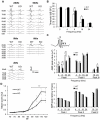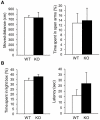Impaired auditory-vestibular functions and behavioral abnormalities of Slitrk6-deficient mice
- PMID: 21298075
- PMCID: PMC3027700
- DOI: 10.1371/journal.pone.0016497
Impaired auditory-vestibular functions and behavioral abnormalities of Slitrk6-deficient mice
Abstract
A recent study revealed that Slitrk6, a transmembrane protein containing a leucine-rich repeat domain, has a critical role in the development of the inner ear neural circuit. However, it is still unknown how the absence of Slitrk6 affects auditory and vestibular functions. In addition, the role of Slitrk6 in regions of the central nervous system, including the dorsal thalamus, has not been addressed. To understand the physiological role of Slitrk6, Slitrk6-knockout (KO) mice were subjected to systematic behavioral analyses including auditory and vestibular function tests. Compared to wild-type mice, the auditory brainstem response (ABR) of Slitrk6-KO mice indicated a mid-frequency range (8-16 kHz) hearing loss and reduction of the first ABR wave. The auditory startle response was also reduced. A vestibulo-ocular reflex (VOR) test showed decreased vertical (head movement-induced) VOR gains and normal horizontal VOR. In an open field test, locomotor activity was reduced; the tendency to be in the center region was increased, but only in the first 5 min of the test, indicating altered adaptive responses to a novel environment. Altered adaptive responses were also found in a hole-board test in which head-dip behavior was increased and advanced. Aside from these abnormalities, no clear abnormalities were noted in the mood, anxiety, learning, spatial memory, or fear memory-related behavioral tests. These results indicate that the Slitrk6-KO mouse can serve as a model of hereditary sensorineural deafness. Furthermore, the altered responses of Slitrk6-KO mice to the novel environment suggest a role of Slitrk6 in some cognitive functions.
Conflict of interest statement
Figures





Similar articles
-
Disorganized innervation and neuronal loss in the inner ear of Slitrk6-deficient mice.PLoS One. 2009 Nov 11;4(11):e7786. doi: 10.1371/journal.pone.0007786. PLoS One. 2009. PMID: 19936227 Free PMC article.
-
A homozygous SLITRK6 nonsense mutation is associated with progressive auditory neuropathy in humans.Laryngoscope. 2014 Mar;124(3):E95-103. doi: 10.1002/lary.24361. Epub 2013 Dec 17. Laryngoscope. 2014. PMID: 23946138 Free PMC article.
-
Rhesus Cochlear and Vestibular Functions Are Preserved After Inner Ear Injection of Saline Volume Sufficient for Gene Therapy Delivery.J Assoc Res Otolaryngol. 2017 Aug;18(4):601-617. doi: 10.1007/s10162-017-0628-6. Epub 2017 Jun 23. J Assoc Res Otolaryngol. 2017. PMID: 28646272 Free PMC article.
-
The mammalian efferent vestibular system plays a crucial role in vestibulo-ocular reflex compensation after unilateral labyrinthectomy.J Neurophysiol. 2017 Apr 1;117(4):1553-1568. doi: 10.1152/jn.01049.2015. Epub 2017 Jan 11. J Neurophysiol. 2017. PMID: 28077670 Free PMC article.
-
Basic organization principles of the VOR: lessons from frogs.Prog Neurobiol. 2004 Jul;73(4):259-309. doi: 10.1016/j.pneurobio.2004.05.003. Prog Neurobiol. 2004. PMID: 15261395 Review.
Cited by
-
Human cytomegalovirus downregulates SLITRK6 expression through IE2.J Neurovirol. 2017 Feb;23(1):79-86. doi: 10.1007/s13365-016-0475-y. Epub 2016 Aug 16. J Neurovirol. 2017. PMID: 27530937
-
Insight into the Association between Slitrk Protein and Neurodevelopmental and Neuropsychiatric Conditions.Biomolecules. 2024 Aug 26;14(9):1060. doi: 10.3390/biom14091060. Biomolecules. 2024. PMID: 39334827 Free PMC article. Review.
-
Transcriptional maturation of the mouse auditory forebrain.BMC Genomics. 2015 Aug 14;16(1):606. doi: 10.1186/s12864-015-1709-8. BMC Genomics. 2015. PMID: 26271746 Free PMC article.
-
The Hole-Board Test in Mutant Mice.Behav Genet. 2022 May;52(3):158-169. doi: 10.1007/s10519-022-10102-1. Epub 2022 Apr 28. Behav Genet. 2022. PMID: 35482162 Review.
-
Subtle alterations of vestibulomotor functioning in conductive hearing loss.Front Neurosci. 2023 Aug 29;17:1057551. doi: 10.3389/fnins.2023.1057551. eCollection 2023. Front Neurosci. 2023. PMID: 37706156 Free PMC article.
References
-
- Aruga J, Mikoshiba K. Identification and characterization of Slitrk, a novel neuronal transmembrane protein family controlling neurite outgrowth. Mol Cell Neurosci. 2003;24:117–129. - PubMed
-
- Aruga J, Yokota N, Mikoshiba K. Human SLITRK family genes: genomic organization and expression profiling in normal brain and brain tumor tissue. Gene. 2003;315:87–94. - PubMed
-
- Patapoutian A, Reichardt LF. Trk receptors: mediators of neurotrophin action. Curr Opin Neurobiol. 2001;11:272–280. - PubMed
-
- Aruga J. Slitrk6 expression profile in the mouse embryo and its relationship to that of Nlrr3. Gene Expr Patterns. 2003;3:727–733. - PubMed
Publication types
MeSH terms
Substances
LinkOut - more resources
Full Text Sources
Molecular Biology Databases
Research Materials

